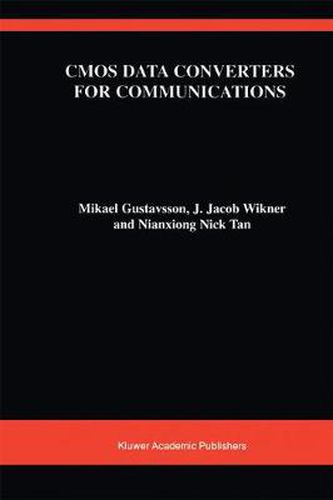Readings Newsletter
Become a Readings Member to make your shopping experience even easier.
Sign in or sign up for free!
You’re not far away from qualifying for FREE standard shipping within Australia
You’ve qualified for FREE standard shipping within Australia
The cart is loading…






This title is printed to order. This book may have been self-published. If so, we cannot guarantee the quality of the content. In the main most books will have gone through the editing process however some may not. We therefore suggest that you be aware of this before ordering this book. If in doubt check either the author or publisher’s details as we are unable to accept any returns unless they are faulty. Please contact us if you have any questions.
This work explains in detail how to derive data converter requirements for a given communication system (baseband, passband, and multi-carrier systems). The authors also review CMOS data converter architectures and discuss their suitability for communications. The rest of the book is dedicated to high-performance CMOS data converter architecture and circuit design. Pipelined ADCs, parallel ADCs with an improved passive sampling technique, and oversampling ADCs are the focus for ADC architectures, while current-steering DAC modelling and implementation are the focus for DAC architectures. The principles of the switched-current and the switched-capacitor techniques are reviewed and their applications to crucial functional blocks such as multiplying DACs and integrators are detailed. CM OS Data Converters for Communications distinguishes itself from other data converter books by emphasizing system-related aspects of the design and frequency-domain measures. The book outlines the design of the basic building blocks such as operational amplifiers, comparators, and reference generators with emphasis on the practical aspects. To operate analogue circuits at a reduced supply voltage, special circuit techniques are needed. Low-voltage techniques are also discussed in this book. This work can be used as a reference book by analogue circuit designers to understand the data converter requirements for communication applications. It can also be used by telecommunication system designers to understand the difficulties of certain performance requirements on data converters.
$9.00 standard shipping within Australia
FREE standard shipping within Australia for orders over $100.00
Express & International shipping calculated at checkout
This title is printed to order. This book may have been self-published. If so, we cannot guarantee the quality of the content. In the main most books will have gone through the editing process however some may not. We therefore suggest that you be aware of this before ordering this book. If in doubt check either the author or publisher’s details as we are unable to accept any returns unless they are faulty. Please contact us if you have any questions.
This work explains in detail how to derive data converter requirements for a given communication system (baseband, passband, and multi-carrier systems). The authors also review CMOS data converter architectures and discuss their suitability for communications. The rest of the book is dedicated to high-performance CMOS data converter architecture and circuit design. Pipelined ADCs, parallel ADCs with an improved passive sampling technique, and oversampling ADCs are the focus for ADC architectures, while current-steering DAC modelling and implementation are the focus for DAC architectures. The principles of the switched-current and the switched-capacitor techniques are reviewed and their applications to crucial functional blocks such as multiplying DACs and integrators are detailed. CM OS Data Converters for Communications distinguishes itself from other data converter books by emphasizing system-related aspects of the design and frequency-domain measures. The book outlines the design of the basic building blocks such as operational amplifiers, comparators, and reference generators with emphasis on the practical aspects. To operate analogue circuits at a reduced supply voltage, special circuit techniques are needed. Low-voltage techniques are also discussed in this book. This work can be used as a reference book by analogue circuit designers to understand the data converter requirements for communication applications. It can also be used by telecommunication system designers to understand the difficulties of certain performance requirements on data converters.